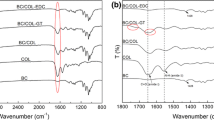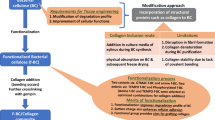Abstract
Composite bacterial cellulose (BC) membranes containing collagen fibrils or collagen monomers (named BC/Col-fibre or BC/Col, respectively) were fabricated by immersing macroporous BC in a 3.0 mg/mL collagen solution for 50 h at 4 °C with or without collagen fibrillogenesis before lyophilization. The structure of the membranes was characterized by scanning electron microscope, nitrogen adsorption–desorption experiment, and X-ray diffraction. The structure became much more compact upon the introduction of collagen but the crystal structure of BC did not change. The thermal stability and the cytocompatibility of the membranes were evaluated by thermogravimetric analysis and a cell adhesion assay, respectively. The thermal stability of BC was enhanced by collagen incorporation and by fibrillogenesis. The adhesive ability and the proliferation of NIH/3 T3 fibroblast cells in BC/Col-fibre were better than that in BC/Col, which was still superior to that in BC.
Graphic abstract
Bacterial cellulose/collagen composite membranes (BC/Col) with and without collagen fibrils were fabricated. The collagen amount was improved to 12% by immersing the macroporous BC in a 3.0 mg/mL collagen solution for 50 h at 4 °C. The collagen fibrils interpenetrated with the BC nanofiber networks to improve the thermostability and the cytocompatibility of BC/Col.









Similar content being viewed by others
References
An B, Lin YS, Broseky B (2016) Collagen interactions: drug design and delivery. Adv Drug Deliv Rev 97:69–84
Bäckdahl H, Helenius G, Bodin A, Nannmark U, Johansson BR, Risberg B, Gatenholm P (2006) Mechanical properties of bacterial cellulose and interactions with smooth muscle cells. Biomaterials 27:2141–2149
Barud HS, Ribeiro CA, Crespi MS, Martines MAU, Dexpert-Ghys J, Marques RFC, Messaddeq Y, Ribeiro SJL (2007) Thermal characterization of bacterial cellulose–phosphate composite membranes. J Therm Anal Calorim 87:815–818
Barud HS, Araujo AM, Santos DB, Assuncao RMN, Meireles CS, Cerqueira DA, Rodrigues G, Ribeiro CA, Messaddeq Y, Ribeiro SJL (2008) Thermal behavior of cellulose acetate produced from homogeneous acetylation of bacterial cellulose. Thermochim Acta 471:61–69
Chattopadhyay S, Raines RT (2014) Review collagen-based biomaterials for wound healing. Biopolymers 101:821–833
Fischer RL, Mccoy MG, Grant SA (2012) Electrospinning collagen and hyaluronic acid nanofiber meshes. J Mater Sci Mater Med 23:1645–1654
Fratzl P, Weinkamer R (2007) Nature’s hierarchical materials. Prog Mater Sci 52:1263–1334
Gao C, Wan Y, Yang C, Dai K, Tang T, Luo H, Wang J (2011a) Preparation and characterization of bacterial cellulose sponge with hierarchical pore structure as tissue engineering scaffold. J Porous Mater 18:139–145
Gao C, Wan Y, Lei X, Qu J, Yan T, Dai K (2011b) Polylysine coated bacterial cellulose nanofibers as novel templates for bone-like apatite deposition. Cellulose 18:1555–1561
Kim DH, Martin JT, Elliott DM, Smith LJ, Mauck RL (2015) Phenotypic stability, matrix elaboration and functional maturation of nucleus pulposus cells encapsulated in photocrosslinkable hyaluronic acid hydrogels. Acta Biomater 12:21–29
Klemm D, Heublein B, Fink HP, Bohn A (2005) Cellulose: fascinating biopolymer and sustainable raw material. Angew Chem Int Ed 44:3358–3393
Lee SJ, Liu J, Oh SH, Soker S, Atala A, Yoo JJ (2008) Development of a composite vascular scaffolding system that withstands physiological vascular conditions. Biomaterials 29:2891–2898
Li Y, Jiang H, Zheng W, Gong N, Chen L, Jiang X, Yang G (2015) Bacterial cellulose–hyaluronan nanocomposite biomaterials as wound dressings for severe skin injury repair. J Mater Chem B 3:3498–3507
Liu X, Dan N, Dan W (2017) Insight into the collagen assembly in the presence of lysine and glutamic acid: an in vitro study. Mater Sci Eng C 70:689–700
Luo H, Xiong G, Huang Y, He F, Wang Y, Wan Y (2008) Preparation and characterization of a novel COL/BC composite for potential tissue engineering scaffolds. Mater Chem Phys 110:193–196
Makris EA, Gomoll AH, Malizos KN, Hu JC, Athanasiou KA (2015) Repair and tissue engineering techniques for articular cartilage. Nat Rev Rheumatol 11:21–34
Marotta M, Martino G (1985) Sensitive spectrophotometric method for the quantitative estimation of collagen. Anal Biochem 150:86–90
O’Brien FJ, Harley BA, Yannas IV, Gibson L (2004) Influence of freezing rate on pore structure in freeze-dried collagen-GAG scaffolds. Biomaterials 25:1077–1806
Roveri N, Falini G, Sidoti MC, Tampieri A, Landi E, Sandri M, Parma B (2003) Biologically inspired growth of hydroxyapatite nanocrystals inside self-assembled collagen fibers. Mater Sci Eng C 23:441–446
Saska S, Teixeira LN, Oliveira PTD, Gaspar AMM, Ribeiro SJL, Messaddeq Y, Marchetto R (2012) Bacterial cellulose-collagen nanocomposite for bone tissue engineering. J Mater Chem 22:22102–22112
Sayin E, Rashid RH, Rodríguez-Cabello JC, Elsheikh A, Baran ET, Hasirci V (2017) Human adipose derived stem cells are superior to human osteoblasts (HOB) in bone tissue engineering on a collagen-fibroin-ELR blend. Bioact Mater 2:71–81
Silver FH, Freeman JW, Seehra GP (2003) Collagen self-assembly and the development of tendon mechanical properties. J Biomech 36:1529–1553
Taboas JM, Maddox RD, Krebsbach PH, Hollister SJ (2003) Indirect solid free form fabrication of local and global porous, biomimetic and composite 3D polymer-ceramic scaffolds. Biomaterials 24:181–194
Tian Z, Duan L, Wu L, Shen L, Li G (2016) Rheological properties of glutaraldehyde-crosslinked collagen solutions analyzed quantitatively using mechanical models. Mater Sci Eng C 63:10–17
Traub W, Piez KA (1997) The chemistry and structure of collagen. Adv Protein Chem 25:243–352
Walters BD, Stegemann JP (2014) Strategies for directing the structure and function of three-dimensional collagen biomaterials across length scales. Acta Biomater 10:1488–1501
Wan YZ, Huang Y, Yuan CD, Raman S, Zhu Y, Jiang HJ, He F, Gao C (2007) Biomimetic synthesis of hydroxyapatite/bacterial cellulose nanocomposites for biomedical applications. Mater Sci Eng C 27:855–864
Wei B, Zhai Z, Wang H, Zhang J, Xu C, Xu Y, He L, Xie D (2018) Graphene-oxide-based FRET platform for sensing xenogeneic collagen coassembly. J Agric Food Chem 66:9080–9086
Wiegand C, Elsner P, Hipler UC, Klemm D (2006) Protease and ROS activities influenced by a composite of bacterial cellulose and collagen type I in vitro. Cellulose 13:689–696
Xiong G, Luo H, Zhang C, Zhu Y, Wan Y (2015) Enhanced biological behavior of bacterial cellulose scaffold by creation of macropores and surface immobilization of collagen. Macromol Res 23:734–740
Yang L, Yang Q, Lu DN (2014) Effect of chemical crosslinking degree on mechanical properties of bacterial cellulose/poly(vinyl alcohol) composite membranes. Monatsh Chem 145:91–95
Yang Q, Ma H, Dai Z, Wang J, Dong S, Shen J, Dong J (2017) Improved thermal and mechanical properties of bacterial cellulose with the introduction of collagen. Cellulose 24:3777–3787
Yano H, Sugiyama J, Nakagaito AN, Nogi M, Matsuura T, Hikita M, Handa K (2005) Optically transparent composites reinforced with networks of bacterial nanofibers. Adv Mater 17:153–155
Zhang Q, Hubenak J, Iyyanki T, Alred E, Turza KC, Davis G, Chang EI, Branch-Brooks CD, Beahm EK, Butler CE (2015) Engineering vascularized soft tissue flaps in an animal model using human adipose–derived stem cells and VEGF + PLGA/PEG microspheres on a collagen-chitosan scaffold with a flow-through vascular pedicle. Biomaterials 73:198–213
Zhang J, Zou M, Zhang M, Wei B, Xu C, Xie D, Wang H (2016) Impact of telopeptides on self-assembly properties of snakehead (channa argus) skin collagen. Food Biophys 11:380–387
Zhang J, Wei B, He L, Xu C, Xie D, Paik KW, Wang H (2017a) Systematic modulation of gelation dynamics of snakehead (channa argus) skin collagen by environmental parameters. Macromol Res 25:1105–1114
Zhang J, Sun Y, Zhao Y, Wei B, Xu C, He L, Oliveira CLP, Wang H (2017b) Centrifugation-induced fibrous orientation in fish-sourced collagen matrices. Soft Matter 13:9220–9228
Acknowledgments
This study was financially supported by the National Natural Science Foundation of China (Nos. 21676208, 21706201, 21376183), the Wuhan Morning Light Plan of Youth Science and Technology (No. 2017050304010326), the Hubei Provincial Natural Science Foundation of China (Nos. 2018CFA030, 2017CFB507), and the Innovation Team Program of Hubei province, China (No. T201208).
Author information
Authors and Affiliations
Corresponding authors
Ethics declarations
Conflict of interest
All authors declare that they have no conflict of interest.
Additional information
Publisher's Note
Springer Nature remains neutral with regard to jurisdictional claims in published maps and institutional affiliations.
Rights and permissions
About this article
Cite this article
Dai, L., Nan, J., Tu, X. et al. Improved thermostability and cytocompatibility of bacterial cellulose/collagen composite by collagen fibrillogenesis. Cellulose 26, 6713–6724 (2019). https://doi.org/10.1007/s10570-019-02530-w
Received:
Accepted:
Published:
Issue Date:
DOI: https://doi.org/10.1007/s10570-019-02530-w




